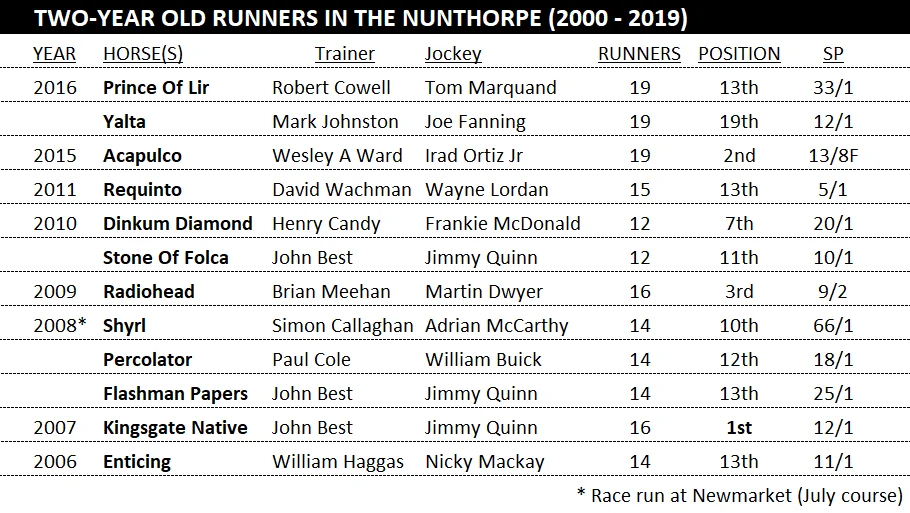Juveniles and the Nunthorpe Stakes
Philip Sale | Friday August 20 2020, 9:33pm | Racing Comment
What a pity there are no two-year-old runners in this year's Nunthorpe Stakes. For a time it appeared the 2020 renewal would boast the strongest representation since 2008 – a year in which no less than three juveniles went to post (those with good memories may recall the 2008 renewal being run at Newmarket’s July course).
For a variety of reasons, the likes of Frenetic, Steel Bull and Golden Pal have fallen by the wayside. Consequently this is the fourth consecutive year without juvenile participation. Indeed, there have only been four such runners in the last decade.
The prospect of two-year-olds taking on their elders is always mouth-watering, not least because such race conditions are a rarity in the racing programme. On first glance, the weight allowances can scarcely be believed.It was 2015 when one of those occasional juvenile runners – Acapulco - finished runner-up to four-year-old Mecca’s Angel. Fresh from her Queen Mary victory, Acapulco ran as well as any juvenile possibly could and carried a featherweight 8st compared to the winner’s 9st 10lb. A memorable race, no doubt, but nevertheless the older mare ultimately exerted her authority by two-lengths.
Whilst at first it seems a no-brainer for connections of high-class, sharp two year olds to take advantage of the tantalising weight allowances, equally it could be viewed as foolhardy. The fact just 12 horses have even attempted the feat in the last two decades (see below chart) suggests trainers and owners generally understand the drawbacks of such an adventurous strategy.

After all, there is an existing two-year-old programme already offering the opportunity to pick up valuable black-type and substantial prize money on a level playing field. Why risk running a young horse against seasoned, hardy professionals when the latter half of the season offers the Lowther, Flying Childers, Firth Of Clyde and Cornwallis, to say nothing of the Mill Reef, Middle Park and Cheveley Park?
With a packed Irish and French schedule to mull over too, trainers are not exactly short on options. A tilt at the Nunthorpe is nothing if not brave.
The speedy Requinto is an interesting case study. In 2011 David Wachman’s colt took in the Nunthorpe fresh from victory in the Molecomb. He was a well-beaten 13th. The following month he returned to juvenile company and duly won the Flying Childers at Doncaster.
Undeterred by their experience at York, connections once-more pitched Requinto in against his elders in the Prix de l’Abbaye. He was again beaten. Coolmore’s commercial interests aside, these were bold strategies which didn’t pay off.
If ever a demonstration were needed on how the thoroughbred racehorse develops, strengthens and matures with age, contests like the Nunthorpe and Prix de l’Abbaye offer the perfect example. Winning these races is not impossible for juveniles but, for many, it is seemingly too much, too soon.
On the surface of it, the Nunthorpe weight-allowances nearly appear extreme, but history has proven them to be faultless. Two-year-olds are patently not at an advantage, even under these unusual conditions.
Be it High Treason in 1953, Lyric Fantasy in 1992 or Kingsgate Native in 2007 - the last two-year-old to win the Nunthorpe - it is just as difficult for a juvenile to win this Group 1 as any other horse. And so it should be.